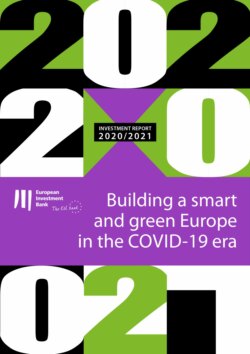Читать книгу EIB Investment Report 2020/2021 - Группа авторов - Страница 31
На сайте Литреса книга снята с продажи.
Aggregate investment dynamics Investment growth continued until the end of 2019, but the pace slowed
ОглавлениеAggregate investment rates continued to rise throughout 2019 in most EU members as investment growth outpaced growth in real gross domestic product (GDP) (Figure 1).[1, 2] The investment rate in the European Union rose above its long-term average at the end of 2019. This rise was also seen in Western and Northern Europe and in Central and Eastern Europe. The aggregate investment rate in Southern Europe, however, was 1.5 percentage points below the average of the past 25 years.
In 2019, aggregate investment in the European Union grew about 3% relative to 2018. Half of this pace of growth resulted from higher investment in buildings and structures, including dwellings (Figure 2a). Investment in other buildings and structures, which includes infrastructure investment (discussed separately in this chapter), expanded at faster rates in Central and Eastern Europe. The investment in buildings and structures was supported by higher government capital expenditure and investment grants from the European Structural and Investment Funds (Figure 3c). Austria, France, Germany and Portugal also saw significant investment increases in buildings and structures.
These positive developments notwithstanding, aggregate investment growth slowed down in the European Union in the second half of 2019 (Figure 2a). The slowdown was due to weakening international trade amid intensifying disputes between the United States and its main trading partners (EIB, 2019). In 2019 and early 2020, before the coronavirus pandemic drew all the attention of analysts and commentators, European economic discourse focused mostly on the weakening of the German economy as a result of falling exports.
Figure 1
Gross fixed capital formation (GFCF) in the European Union and the United States (% of real GDP)
Source: Eurostat, Organisation for Economic Co-operation and Development (OECD) national accounts and EIB staff calculations.
Note: Real investment and GDP are in euro 2015 chain-linked volumes and US dollar 2014 chain-linked volumes for the European Union and the United States, respectively. The aggregate for Western and Northern Europe does not include Ireland, due to the high volatility of Irish data that obscures group-wide developments.
Figure 2
Real GFCF and contribution by asset type (% change from a year earlier)
Source: Eurostat and OECD national accounts; EIB staff calculations.
Note: Panel a shows data for the European Union without Ireland, due to high volatility of Irish investment data that obscures EU-wide developments.
Part of the slowdown came from investment in machinery and equipment and in buildings and structures, including dwellings. Investment ran out of steam first in Southern Europe in early 2019 (Figure 3b), mostly due to a pronounced slowdown in Italy. By the third quarter of 2019, the phenomenon had spread to Western and Northern Europe, as investment growth waned in Austria, the Nordic countries and Germany (Figure 3a).
Unlike the European Union, investment in the United States was driven almost entirely by acquisitions of equipment and intellectual property and did not slow down in 2019 (Figure 2b). The United States has outperformed the European Union on investment in these two asset types throughout the past ten years, increasing the gap between the two economies. These types of investment are particularly important as they are likely to contribute to firm productivity and competitiveness and, as a consequence, aggregate economic productivity (EIB, 2018 and EIB, 2019).
Figure 3
Real GFCF and contribution by asset type, European Union (% change from a year earlier)
Source: Eurostat and EIB staff calculations.
